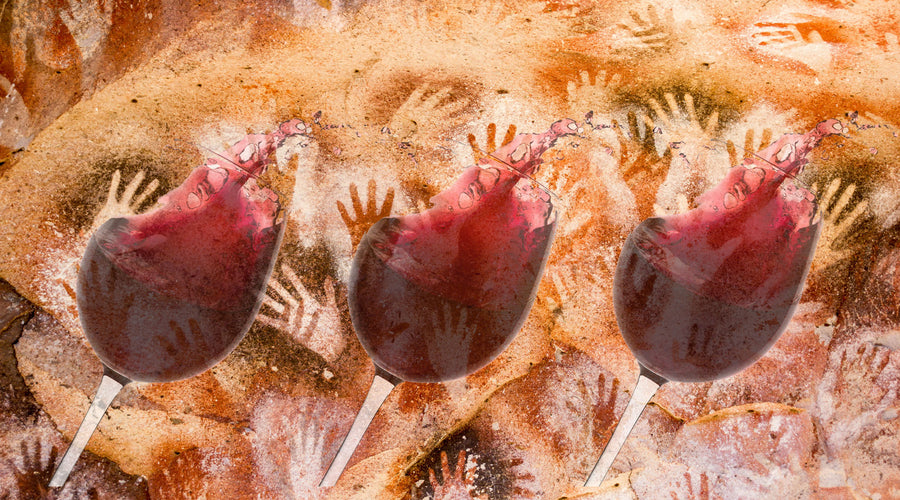Only a Stone’s Throw Away
"The more I have learned about wine ... the more I have realized that it weaves in with human history from its very beginning as few, if any, other products do. Textiles, pottery, bread ... there are other objects of daily use that we can also trace back to the Stone Age. Yet wine alone is charged with sacramental meaning, with healing powers; indeed, with a life of its own." - HUGH JOHNSON
Recent research presented by the American Association for the Advancement of Science revealed findings that suggested grapes for wine and/or eating were first farmed about 11,000 years ago, or 9,000 BC. This time period is often referred to as the Mesolithic or middle Stone Age, which goes from 10,000 to 8,000 BC. It is around this 10,000 BC mark that it is generally thought that people started farming but as with all things in archaeology, research is still ongoing and debatable.
Researchers further analyzed the genetic data from about 3,500 grape varieties worldwide. The DNA analysis allowed the team to trace the evolution and domestication histories of these grape varietals. The results suggested that table grapes (primarily for eating) and wine grapevines were domesticated at the same time in Western Asia and the Caucasus region (a region between the Black Sea and the Caspian Sea).
These domestication events took place 11,000 years ago, in line with the advent of farming. We know that the grapes in these regions are genetically suitable for making great wine. The study argued that whereas those vines domesticated in Western Asia gave rise to the table grapes we eat today, those in the Caucasus would eventually come to be used for winemaking. Whether ancient humans had the know-how to make wine right at the beginning is still debatable.
Currently, the oldest evidence for winemaking dates to about 8,000 years ago (about 6,000 BC). Archaeologists uncovered signs of large-scale wine production in the country of Georgia which is also a part of the Caucasus region. However, humans likely had the tools and knowledge to make alcohol long before this. Although, archaeological evidence gets harder to identify the further back in time researchers look. The grapevine was probably the first fruit crop domesticated by humans and was one of the first globally traded goods.
A Tale of Two Regions:
A widespread tale shared by many ancient Mediterranean cultures was that the Vine began its existence from the blood of humans who had fought against the Gods.
Another was a Persian tale of King Jamsheed, otherwise unknown in that country’s dynastic history. The monarch was fond of fresh grapes and stored them in jars to have a year-round supply. One particular jar unfortunately went bad, and the jar was labeled as poison. Suffering from severe headaches, a harem consort then mistakenly drank from the jar and fell into a deep sleep, to awake miraculously cured. She informed the king of what had happened, and, in his wisdom, he discerned that the “poison” was actually fermented grape juice or wine with medicinal effects. He then ordered more of such poison to be prepared, and thus humanity embarked upon its ages-long wine odyssey. It was also said that he would be able to see his Kingdom in a cup of wine.
A Prehistoric Observation:
Our observant prehistoric ancestors would have seen birds and other mammals eagerly eating the fermented grapes. Their intrigue would have been aroused if they saw any ensuing uncoordinated muscular movements (robins have been known to fall off their perches). Sooner or later, humans would have carried out some firsthand experimentation. Organisms as different as the fruit fly and the elephant gravitate to fermented fruits, and they have similar physiological responses. In the most general sense, their preferences are understandable because sugar fermentation (or glycolysis) is the earliest form of energy production for sustaining life. It is hypothesized that the earliest microbes dined on simple sugars in the primordial soup of 4 billion years ago and excreted ethanol and carbon dioxide. Yeast carries out a similar kind of anaerobic metabolism today, although they are hardly primitive; their single cells contain many of the same organelles as a multicellular plant or animal as well as a nucleus with chromosomes. Their ethanol production is like a signal sent up to the sugar lovers of the world, since this pungent, volatile compound leads back to a source of glucose or fructose. Our common biological heritage with Stone Age humans, with a mental acuity similar to our own, strongly supports the Paleolithic Hypothesis. Yet it is extremely unlikely that the supposition will ever be proved. The greatest obstacle in the way of the Paleolithic Hypothesis is the improbability of ever finding a preserved container with intact ancient organics or microorganisms that can be identified as exclusively due to wine.
The question will remain with us for sometime as to whether these first harvested grapes were for eating, or fermenting into alcohol, (or both). Regardless, it is clearly justifiable to state that the domestication of the grapevine was truly one of the driving forces of civilization.
Recent research presented by the American Association for the Advancement of Science revealed findings that suggested grapes for wine and/or eating were first farmed about 11,000 years ago, or 9,000 BC. This time period is often referred to as the Mesolithic or middle Stone Age, which goes from 10,000 to 8,000 BC. It is around this 10,000 BC mark that it is generally thought that people started farming but as with all things in archaeology, research is still ongoing and debatable.
Researchers further analyzed the genetic data from about 3,500 grape varieties worldwide. The DNA analysis allowed the team to trace the evolution and domestication histories of these grape varietals. The results suggested that table grapes (primarily for eating) and wine grapevines were domesticated at the same time in Western Asia and the Caucasus region (a region between the Black Sea and the Caspian Sea).
These domestication events took place 11,000 years ago, in line with the advent of farming. We know that the grapes in these regions are genetically suitable for making great wine. The study argued that whereas those vines domesticated in Western Asia gave rise to the table grapes we eat today, those in the Caucasus would eventually come to be used for winemaking. Whether ancient humans had the know-how to make wine right at the beginning is still debatable.
Currently, the oldest evidence for winemaking dates to about 8,000 years ago (about 6,000 BC). Archaeologists uncovered signs of large-scale wine production in the country of Georgia which is also a part of the Caucasus region. However, humans likely had the tools and knowledge to make alcohol long before this. Although, archaeological evidence gets harder to identify the further back in time researchers look. The grapevine was probably the first fruit crop domesticated by humans and was one of the first globally traded goods.
A Tale of Two Regions:
A widespread tale shared by many ancient Mediterranean cultures was that the Vine began its existence from the blood of humans who had fought against the Gods.
Another was a Persian tale of King Jamsheed, otherwise unknown in that country’s dynastic history. The monarch was fond of fresh grapes and stored them in jars to have a year-round supply. One particular jar unfortunately went bad, and the jar was labeled as poison. Suffering from severe headaches, a harem consort then mistakenly drank from the jar and fell into a deep sleep, to awake miraculously cured. She informed the king of what had happened, and, in his wisdom, he discerned that the “poison” was actually fermented grape juice or wine with medicinal effects. He then ordered more of such poison to be prepared, and thus humanity embarked upon its ages-long wine odyssey. It was also said that he would be able to see his Kingdom in a cup of wine.
A Prehistoric Observation:
Our observant prehistoric ancestors would have seen birds and other mammals eagerly eating the fermented grapes. Their intrigue would have been aroused if they saw any ensuing uncoordinated muscular movements (robins have been known to fall off their perches). Sooner or later, humans would have carried out some firsthand experimentation. Organisms as different as the fruit fly and the elephant gravitate to fermented fruits, and they have similar physiological responses. In the most general sense, their preferences are understandable because sugar fermentation (or glycolysis) is the earliest form of energy production for sustaining life. It is hypothesized that the earliest microbes dined on simple sugars in the primordial soup of 4 billion years ago and excreted ethanol and carbon dioxide. Yeast carries out a similar kind of anaerobic metabolism today, although they are hardly primitive; their single cells contain many of the same organelles as a multicellular plant or animal as well as a nucleus with chromosomes. Their ethanol production is like a signal sent up to the sugar lovers of the world, since this pungent, volatile compound leads back to a source of glucose or fructose. Our common biological heritage with Stone Age humans, with a mental acuity similar to our own, strongly supports the Paleolithic Hypothesis. Yet it is extremely unlikely that the supposition will ever be proved. The greatest obstacle in the way of the Paleolithic Hypothesis is the improbability of ever finding a preserved container with intact ancient organics or microorganisms that can be identified as exclusively due to wine.
The question will remain with us for sometime as to whether these first harvested grapes were for eating, or fermenting into alcohol, (or both). Regardless, it is clearly justifiable to state that the domestication of the grapevine was truly one of the driving forces of civilization.





